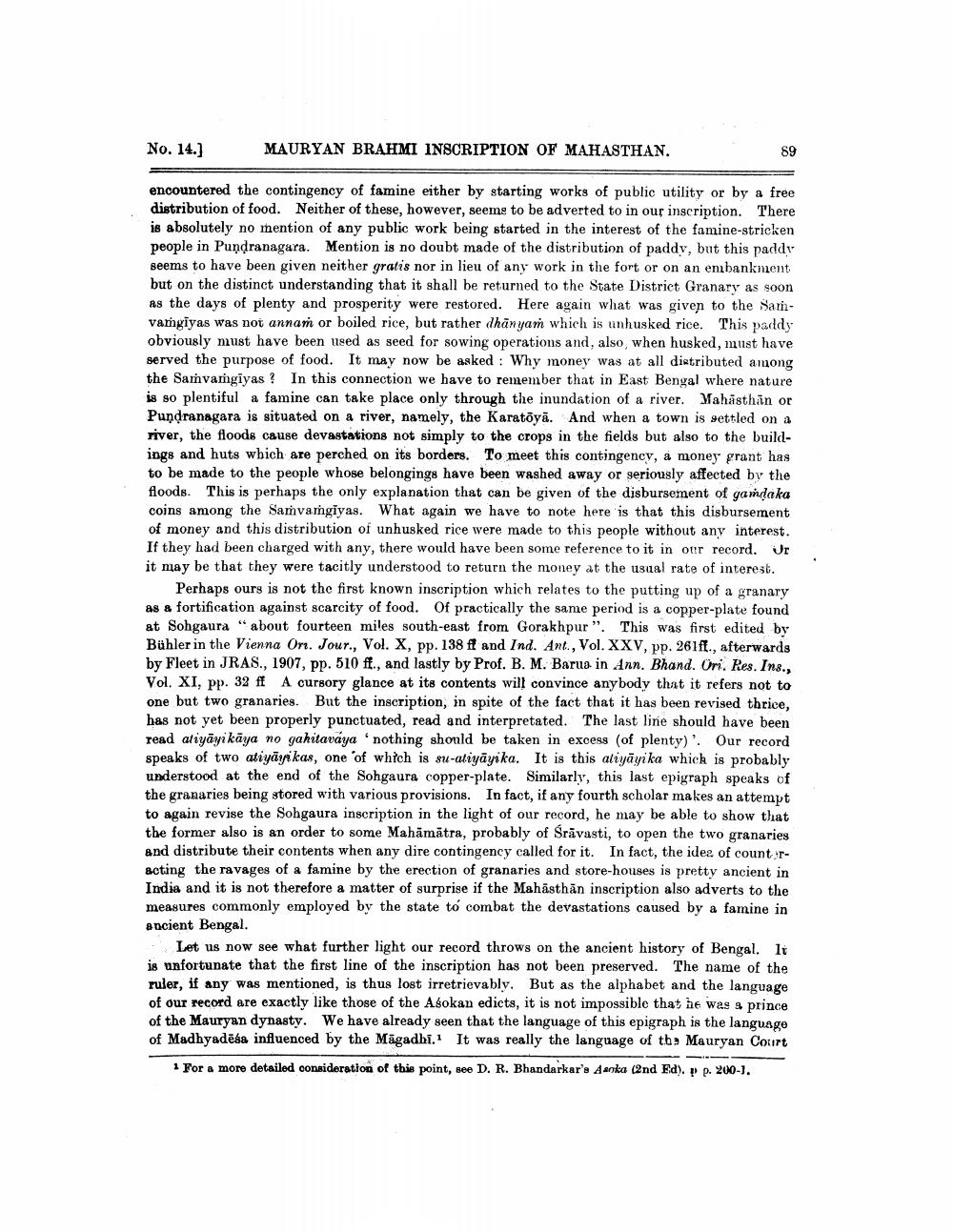________________
No. 14.]
MAURYAN BRAHMI INSCRIPTION OF MAHASTHAN.
89
encountered the contingency of famine either by starting works of public utility or by a free distribution of food. Neither of these, however, seems to be adverted to in our inscription. There is absolutely no mention of any public work being started in the interest of the famine-stricken people in Pundranagara. Mention is no doubt made of the distribution of paddy, but this paddy seems to have been given neither gratis nor in lieu of any work in the fort or on an enbankment but on the distinct understanding that it shall be returned to the State District Granary as soon as the days of plenty and prosperity were restored. Here again what was given to the Samvamgiyas was not annam or boiled rice, but rather dhānyam which is unhusked rice. This paddy obviously must have been used as seed for sowing operations and, also, when husked, must have served the purpose of food. It may now be asked : Why money was at all distributed among the Samvamgiyas? In this connection we have to remember that in East Bengal where nature is so plentiful a famine can take place only through the inundation of a river. Mahāsthān or Pundranagara is situated on a river, namely, the Karatöyā. And when a town is settled on a river, the floods cause devastations not simply to the crops in the fields but also to the buildings and huts which are perched on its borders. To meet this contingency, à money grant has to be made to the people whose belongings have been washed away or seriously affected by the floods. This is perhaps the only explanation that can be given of the disbursement of gandaka coins among the Samvamgiyas. What again we have to note here is that this disbursement of money and this distribution of unhusked rice were made to this people without any interest. If they had been charged with any, there would have been some reference to it in our record. Ur it may be that they were tacitly understood to return the money at the usual rate of interest.
Perhaps ours is not the first known inscription which relates to the putting up of a granary as & fortification against scarcity of food. Of practically the same period is a copper-plate found at Sohgaura "about fourteen miles south-east from Gorakhpur". This was first edited by Bühler in the Vienna Or. Jour., Vol. X, pp. 138 ff and Ind. Ant., Vol. XXV, pp. 261ft., afterwards by Fleet in JRAS., 1907, pp. 510 ff., and lastly by Prof. B. M. Barua in Ann. Bhand. Ori. Res. Ins., Vol. XI, pp. 32 ff A cursory glance at its contents will convince anybody that it refers not to one but two granaries. But the inscription, in spite of the fact that it has been revised thrice, has not yet been properly punctuated, read and interpretated. The last line should have been read aliyāyi kāya no gahitavaya 'nothing should be taken in excess of plenty). Our record speaks of two atiyāyikas, one of which is su-atiyāyika. It is this aliyāyika which is probably understood at the end of the Sohgaura copper-plate. Similarly, this last epigraph speaks of the granaries being stored with various provisions. In fact, if any fourth scholar makes an attempt to again revise the Sohgaura inscription in the light of our record, he may be able to show that the former also is an order to some Mahāmātra, probably of Srāvasti, to open the two granaries and distribute their contents when any dire contingency called for it. In fact, the idea of countracting the ravages of a famine by the erection of granaries and store houses is pretty ancient in India and it is not therefore a matter of surprise if the Mahästhān inscription also adverts to the measures commonly employed by the state to combat the devastations caused by a famine in ancient Bengal. - Let us now see what further light our record throws on the ancient history of Bengal. It is unfortunate that the first line of the inscription has not been preserved. The name of the ruler, if any was mentioned, is thus lost irretrievably. But as the alphabet and the language of our record are exactly like those of the Asokan edicts, it is not impossible that he was a prince of the Mauryan dynasty. We have already seen that the language of this epigraph is the language of Madhyadēša influenced by the Māgadhi. It was really the language of tbMauryan Court
1 For a more detailed consideration of this point, see D. R. Bhandarkar's Aenka (2nd Ed). p. 200-1.




